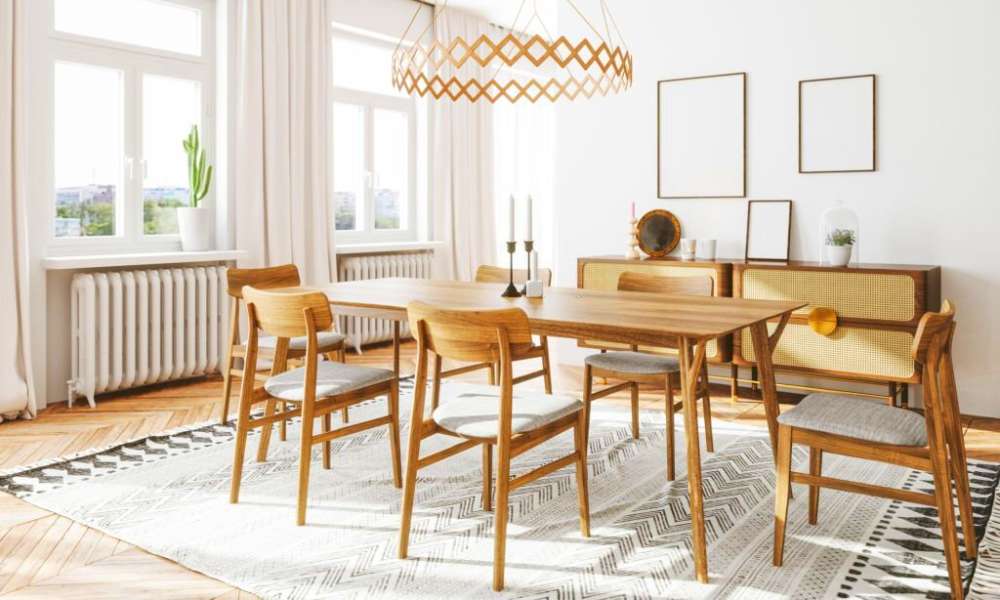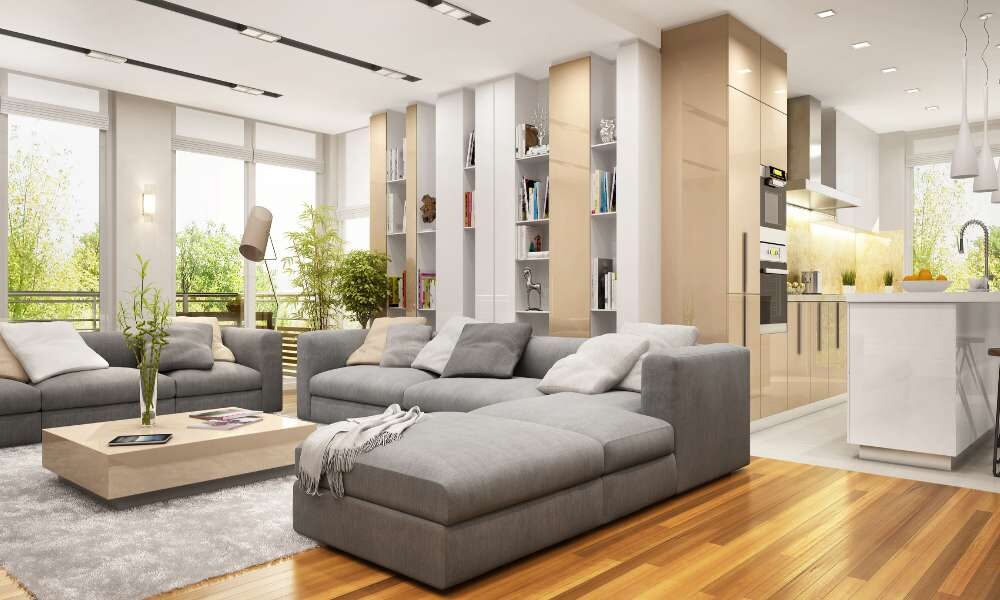Many people choose to combine their living and dining rooms into one large space. However, there are a few ways to separate the two areas so that they can be used separately. One way is to use a wall partition. This will create a separate space that can be used for both activities. Another option is to use furniture. You can choose to have a more formal dining table in the living room or opt for a more casual setting with chairs placed around the TV. In this article, we inform you how to separate living room and dining room. There are some easy guides to doing that job.
What Is The Living Room?

The living room is often thought of as the main room in a house. It’s where people gather to watch TV, relax after work, or entertain guests. But what is the living room actually? Is it just one big space with a TV and some furniture? Or is it something more special, with its own separate entrance and all its own functions?
In most cases, the living room is actually a separate space from the dining room. You may have one large open space with no walls separating them, or you may have two rooms that are divided by a wall or door. The important thing is that the two spaces have their own specific uses and aren’t just used for general activities like watching TV.
For more formal events like dinner parties or get-togethers with friends, the living room can be used.
What Is The Dining Room?

When most people think of a dining room, they imagine a formal space with delicate china and matching silverware. But in reality, a dining room can be just as informal or even casual as the rest of your home. A dining room can also serve as a separate living room if you have enough seating for everyone and don’t mind separating the two spaces. So whether you’re looking to update your existing dining room or create a brand new one altogether.
Consider what type of atmosphere you want to create. If you want something more formal, consider opting for darker furniture and tones along with heavy curtains or drapes. If you’re more relaxed and like to entertain frequently, go for brighter colors and patterns that will flow into the rest of your home.
What Benefits Of The Separate Living Room And Dining Room?
The main benefit of having a separate living room and dining room is that it can give your home the feeling of being more spacious. This can be especially beneficial if you have a small home or if you want to create more space for entertaining guests. Additionally, having a living room and dining room on different levels can also make them easier to access from different parts of your home.
Here Are Some Guides To Separating The Living Room And Dining Room
The living room and dining room can be two different spaces in your home. They can be separated by a wall or by furniture, but sometimes these boundaries get blurry.
Here are some guides to help you separate the living room and dining room
- Decide What Separates The Living Room From The Dining Room. Is It A Wall? Is It Furniture?
- If You Can’t Separate Them By Furniture, Consider Using Wallpaper Or Paint To Define The Boundaries
- Make Sure There’s Enough Storage Space In The Living Room And Dining Room So That You Can Store Your Stuff Easily
- If You Want To Bring The Living Room Into The Dining Area, Try Putting A Table In Between Them Or Use Some Low Tables That Won’t Block Views
Using Hypnotic Lattice Dividers To Separate
Hypnotic Lattice Dividers can be a great way to separate the living room from the dining room in your home. This type of divider is made with a series of panels that are hypnotically attractive and create a natural barrier between the two spaces. When it comes to creating a separation in your home. This type of divider is an excellent choice due to its attractive design, easy installation, and overall functionality.
Add Double-duty Display Units In The Separate Living Room And Dining Room
Are you looking for a way to add double-duty display units to your separate living room and dining room? If so, you may be thinking about installing wall-mounted displays. However, if you have limited space or are looking for a more cost-effective option, you may want to consider installing floor-mounted displays.
There are a few things to keep in mind when selecting a floor-mounted display unit: First, make sure the unit is large enough to fit your needs. Second, consider how much storage space you have available and whether the unit will require any additional installation hardware. Third, make sure the unit is easy to access and use. Finally, be sure to choose a display that matches your home’s style and color scheme.
Install A Lattice Screen To Separate
Do you want to create a separation between your living room and dining room but don’t know where to start? Install a lattice screen! This simple, inexpensive solution will help create the perfect environment for relaxing in one space or entertaining in the other.
Here are some tips to get started
- Choose the right type of lattice screen. There are three main types of screens: horizontal, vertical, and diagonal. Horizontal and vertical screens are the most common, and they’re both effective at separating spaces. Diagonal screens are less common but offer an interesting look.
- Measure your space. Before you buy anything, measure the space you want to separate into two rooms and buy the appropriate size lattice screen. Larger screens can be separated into several smaller ones if needed, so it’s worth getting a little extra space if necessary.
Make A Statement With Lights
Are you looking to separate your living room from your dining room, but don’t know where to start?
Here are some ideas for making a statement with lights in each space
- Use a bold light fixture in the living room to draw attention to the space. This can be a chandelier or a large lighted mirror.
- If you have a small dining area, install smaller lights near the table so people can see their food as they eat.
- If you have more space, use larger fixtures and set them farther apart to create a focal point in the room.
- Consider using accent lamps to add personality to specific areas of your home, such as by your fireplace or on an end table near the TV.
Use The Humble Floor Mat
Do you want to keep your living room and dining room separate but still have them be one space? The humble floor mat can help you do just that! By placing a mat between the two rooms, you can create a barrier that keeps things clean and separate. Not to mention, it’ll add a touch of style to your home. Whether you use a traditional mat or something more unique, there are plenty of options available on the market today. So whether you’re looking for a practical solution or just something fun and stylish, take a look at the humble floor mat!
Go With Accent Walls
Separate living and dining rooms can feel like an awkward divide, but if you go with accent walls. You can create a functional and beautiful space that works for your needs. Accent walls can be used to create a visual separation between the two spaces or to add personality and depth to an otherwise bland room.
Whether you want to add a pop of color or simple contrast, accent walls are a great way to personalize your space while still keeping it functional. If you’re considering adding an accent wall in your living room. But aren’t sure where to start, consider using one of our favorite designs as inspiration. With so many options available, there’s no reason not to give accent walls a try – they’re definitely worth it!
Mix Up Furniture Styles To Separate Living Room Dining Room
Separating living and dining rooms can be a challenge, but with a little creativity. You can mix and match furniture styles to create the perfect space for each activity. For example, if you want to use your living room for lounging and watching TV, you could mix in a few large couches. If you’re more interested in hosting dinner parties or social events, opt for more formal pieces like a formal dining table and chairs. The key is to find pieces that work well together and create an aesthetic that suits your needs.
Dividing With Color
Dividing walls is a common way to create separate living and dining areas in a home. But what if you don’t want to use color as your cue? There are other ways to create distinct spaces, like using furniture or wall treatments
Here are eight tips for dividing rooms without resorting to color:
- Start with the furniture. If you have large pieces of furniture that take up a lot of space, try moving them around so that they’re not in the same area all the time. This will help to create a visual separation between the living and dining areas.
- Use wall treatments. Some people prefer to use wall treatments instead of dividing walls themselves. This is because wall treatments can be more versatile and changeable, which can help to keep a room looking fresh over time.
- Use light and dark colors together.
Use Some Introduce A Divider
The living room and dining room can be quite different spaces. They may have different purposes, and it can be helpful to keep them separated by a divider. There are many options for dividers, so it’s important to find one that works well with the space and your lifestyle. Some examples of dividers you might consider include curtains, paneling, or even a screen. It’s also important to think about how you’ll use the divider. If it’s primarily for visual distinction or if it will function as an actual barrier between the rooms.
Add Introduce A Carpet To Divide The Living Room And Dining Room
Adding a carpet to divide the living room and dining room can create a more welcoming space for guests. It can also help to separate the two areas so that they are more distinct in terms of function. When selecting a carpet, it is important to consider both the size and style of the room. A small, flat rug is best suited for a smaller space, while a larger, plush rug may be better for a larger area.
Demarcate The Flooring
Designers often divide a room into two different areas. The living room and the dining room. Many people choose to have a separate floor for each, but this is not always necessary. A good way to demarcate these areas is by using furniture placement and colors. If you want to keep the living room and dining room separate, try to place your furniture in a corner or on an edge of the room. Make sure that all of your furniture is neutral in color. So it will not be too disruptive when mixing and matching pieces between the two rooms. Additionally, avoid brightly colored chairs or couches, as they can easily clash with walls and other furniture in the living room.
Final Thoughts
In conclusion, there are a few things to keep in mind when trying to separate the living room and dining room. First, be sure to measure the space carefully to make sure there is enough room for both rooms. Second, consider using different colors, materials, or textures to divide the space. And finally, think about how you will use each area- are the living room spaces more relaxed and inviting with comfortable furniture and artwork, or are they more formal and reserved?




